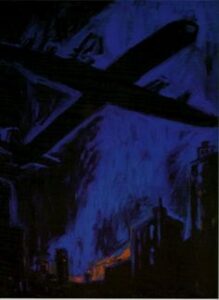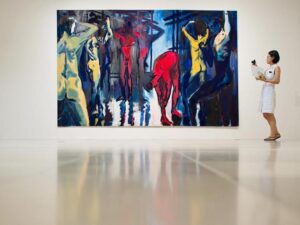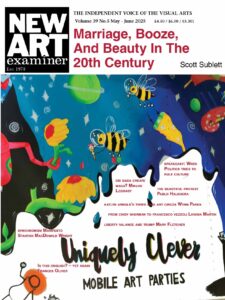
SUMMARY: The Museum of Modern Art’s “Berlinart: 1961-1987” is marred both by serious omissions and the inclusion of too many artists. Nevertheless, the show is important and worth seeing because the art produced in that unique city reflects the role of political, social and cultural issues in the development of art in the 20th century.
The moment you enter it, the Museum of Modern Art’s “Berlinart: 1961-1987” plunges you into an atmosphere as dark, dense and edgy as the city itself.
The brooding cityscapes that open the show in New York are like an operatic backdrop. On the right is the looming facade of K.H. Hodicke’s “War Ministry.” On the left is Paul-Armand Cette’s deadpan photographic survey of trees spreading their leafy branches over the parks of Berlin’s bombed-out palaces and embassies.
Dead ahead is Georg Baselitz’s mock heroic painting of two Wagnerian figures in lederhosen standing amid ruins; a fallen flag lies at their feet. Collectively, these works and others near them speak eloquently of a great city brought low by war and isolation but still intensely and dangerously alive.
Step a little farther into the show and you are struck by Bernd Zimmer’s paint–splattering, gold-and-lapis impression of Berlin nightlife hanging next to Hodicke’s “Nocturne,” a

painting of the city as a stalking cat playing with a speeding car. And then there is Helmut Middendorf’s “Airplane Dream,” a vision of the ultimate 20th century nightmare — a huge plane flying over burning buildings lit up against the night sky.
It is impossible to detach this art from the geographic-political situation of West Berlin as an outpost of the West isolated within the Soviet bloc. It is no accident that the bracketing dates of the exhibition begin with 1961, the year the Berlin Wall was erected by the East German government.
The opening gallery is a portrait of Berlin as a pressure cooker with the valve stopped up. Its powerful paintings engender a sense of recognition and identity that caused President John F Kennedy during a 1963 visit to say, “lch bin ein Berliner.”
Unfortunately, the show does not sustain this intensity. Curator Kynaston McShine has tried to convey the multiple levels and different constellations of artistic activity in Berlin and its history and atmosphere over 26 years. But it is simply too massive a task to accomplish in a single show.
The exhibition includes 55 artists from 10 countries, many of whom made only fleeting visits to Berlin. Christo’s project of wrapping the Reichstag, the German Parliament building burned in 1933, exists only as a drawing. American artist Jonathan Borofsky stayed long enough to execute one of his trademark running men on the Berlin Wall. The government of West Germany subsidized numerous foreign artists to do their thing in Berlin; too many have been included.
Given this overload, it is not surprising that the show bogs down in its own complexity. Artists who are really identified with Berlin — Bernd Koberling, Dieter Hacker, even Markus Lupertz — never have the opportunity to gain definition or come to life.
McShine also lavishes vast wall space on relatively minor figures, such as the Austrian Gunter Brus, or on rising reputations, such as Eva-Maria Schon. Overall, the show has the catchall appearance of a local survey rather than a considered distillation of the immense influence Berlin has exerted on recent contemporary art. It seems like a glorious opportunity missed.
McShine does have his heroes, though. Chief among them, and rightly so, is Baselitz, who with Eugen Schonebeck published a landmark manifesto, “Pandemonium,” in 1961, the fateful year that begins the show. Reasserting their ties with the German expressionists of the early 20th century, these two artists, both of whom emigrated from East Germany to study in Berlin, revived the tradition of intensely emotional, gestural, figurative painting that has since become the hallmark of recent German art.
It is almost as if the building of the wall functioned as an amnesia-curing trauma. In the century’s first decades, Berlin was where expressionism’s widely scattered seeds flowered into the most intense bloom in writing, theater, the visual arts and film. All this activity was brought to a grinding halt by the Nazis.
Immediately after the war, German artists wanted only to rebuild their links with the international avant-garde, then dominated by the New York abstract expressionists. German nationality and art history were forbidden territory.
Baselitz is represented in the show by 22 paintings and drawings, far more than any other artist. For those who are familiar only with his later paintings of upside-down figures, these early works are both enlightening and impressive.
Several galleries are devoted to conceptual and performance artists, many of whom belonged to a loose alliance of latter-day Dadaists known as Fluxus. Particularly memorable is the work of Wolf Vostell, whose savage collage series “Berlin Fever” recalls the collages of an earlier Berlin Dadaist, John Heartfield.
Recorded in photographs, the metaphorical playacting of performance artists makes a kind of absurd sense in the politically pressured atmosphere of Berlin. The most famous German performance artist, Joseph Beuys, swept up and exhibited the refuse from a May Day parade. American Allan Kaprow built “A Sweet Wall,” concrete blocks cemented with bread and jam.
A third nexus of significant activity, represented in the exhibit, is the Moritzplatz group consisting of Rainer Fetting, Middendorf, Luciano Castelli and Salome — known collectively as the New Wild Ones. These four take expressionist defiance to new levels of violence, filling vast expanses of canvas with images of transvestites, nude men, artists as martyrs. At best, their works convey a seething mass hysteria. At worst they expose the core of nothingness that often lies behind the fury of expressionism.
As the catalog makes clear, there is one important strain of Berlin art not represented — the critical realism of Wolfgang Petrick, Peter Sorge, H.J. Diehl and Ulrich Baehr. The absence of their social and political commentary makes the show’s portrayal of the city less credible.
In Berlin, the extremes of conceptualism and expressionism were played out against a conflicted backdrop of harsh political realities on the one hand and generous cultural subsidies from the West German government on the other.
It is interesting that the group of artists who tried to portray directly the ugly realities of the situation instead of romanticizing them has been read out of Berlin history in this exhibit. Instead, the curator has chosen to include the work of publicity-hungry, peripatetic avant-gardists such as Christo and Borofsky, who bring out the same bag of stale tricks no matter where they are.
Despite these serious omissions and the chaotic feel of the show, “Berlinart: 1961–1987,” which runs through Sept. 8, is well worth seeing and pondering. New York bohemianism is an artificial construct; Berliners truly live on the edge. As a result, their art revives the passionate engagement with political, social and cultural issues that played a profoundly important role in the development of 20th century art.

Jane Addams Allen 1986
Volume 34 no 3 January – February 2020 pp 14-17


I do not think Berlin was ever on edge as much as the pressure in East Germany …. and now that has been lifted…are Berliner’s nostalgic for the cold war?
Nostalgia is possible for anything. place or time as long as the element of personal danger or pain is eliminated unless the person concerned extracts pleasure from a sense of danger or pain. Nostalgia is a powerful weapon for those creating propaganda.
There is the tortured psyche of the nation in these images though; I think thats a part of the edge.
I have an extraordinary etching from this period by Norbert Behrend (born 1939), depicting time stopped at Berlin’s Friedrichstrasse railway station, also known as the “Palace of Tears”. In the brown and white etching, the clock has no hands. It’s eerie and quite beautiful at the same time. This little known artist outside Berlin merits being written about. He is one of the finest etchers of his time, while the images he made are a historic remembrance of this era, not to be forgotten.
Could life be more on the edge than it is now? As we witness the precipice of the world as we know it, we may wake up after the coronavirus has infected us all, or all those that it is going to infect, and find a new world in front us. Undoubtedly, there are going to be changes, which at the present time are life threatening and are impeding our individual freedom of movement, but not our freedom of expression.
It is a time to rethink our current attitudes and to draw conclusions on how to go forward. When we wake up from this nightmare and perhaps find our lifestyles and livelihoods changed, we might finally find that joy that was missing from our lives and stop living for “things”.
Hi Tani Rossi. The nightmare of the virus recalls memories of the past. I was born in 1936; I remember wartime but did not really understand the depth of fear and the reality of what was going on. Only later did I have a fuller understanding. The war effort in the UK brought about profound change. As maybe as this virus will bring about. Unfortunately, society needs an enemy or a profound threat to exhibit humanity and tolerance to fellow citizens. I was embedded with a romantic notion that after the war we (the British people) would enter into a society that love and tolerance would be the order of the day. Though profound cages did happen, National health service came about and also the demands of privilege and status were modified, they were not dismantled totally. I sense in our anxiety-prone society of today a similar call for social progress. Certainly, I sense the great dissatisfaction in which the rich get richer and the poor get poorer. My personal dream was that the art world foster a generosity of spirit that I did not find in normal society. I am forced to think this is not so. It is time to rethink our current attitudes on how to go forward. In the meantime I and colleagues find joy in art, we also find other human attributes which is reasonable. We try to talk about what we find. Unfortunately, it is a very dangerous social activity given the nature of our society which is media drenched and celebrity-driven. Certainly freedom of expression is under attack, even in universities,… I could cite chapter and verse, if I do in our present culture it sounds like whining.
In her review Jane Allen talks about how “the art produced in” Berlin “reflects the role of political, social and cultural issues in the development of art in the 20th century.” I want to see how art works produced after the coronavirus will reflect the changes this will necessarily bring about to our society and politics.
Good question, May.
Considering our current circumstances, there’s a very interesting read on “the pandemic of today is the great art of tomorrow”. It’s in none other than RT News:
https://www.rt.com/op-ed/484297-covid-art-culture-dali/